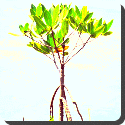 Mangrove — Mangroves (generally) are trees and shrubs that grow in saline coastal habitats in the tropics and subtropics. The word is used in at least three senses, (1) most broadly to refer to the habitat and entire plant assemblage or mangal, for which the terms mangrove swamp and mangrove forest are also used, (2) to refer to all trees and large shrubs in the mangal, and (3) narrowly to refer to the mangrove family of plants, the Rhizophoraceae, or even more specifically just to mangrove trees of the genus Rhizophora. Mangals are found in depositional coastal environments where fine sediments, often with high organic content, collect in areas protected from high energy wave action.
Mangrove — Mangroves (generally) are trees and shrubs that grow in saline coastal habitats in the tropics and subtropics. The word is used in at least three senses, (1) most broadly to refer to the habitat and entire plant assemblage or mangal, for which the terms mangrove swamp and mangrove forest are also used, (2) to refer to all trees and large shrubs in the mangal, and (3) narrowly to refer to the mangrove family of plants, the Rhizophoraceae, or even more specifically just to mangrove trees of the genus Rhizophora. Mangals are found in depositional coastal environments where fine sediments, often with high organic content, collect in areas protected from high energy wave action.
A mangal is a plant community and habitat where mangroves thrive. They are found in tropical and sub-tropical tidal areas, and as such have a high degree of salinity. Areas where mangals occur include estuaries and marine shorelines.
Plants in mangals are diverse, but all are able to exploit their habitat (the intertidal zone) by developing physiological adaptations to overcome the problems of anoxia, high salinity and frequent tidal inundation. About 110 species have been identified as belonging to the mangal. Each species has its own capabilities and solutions to these problems; this may be the primary reason why, on some shorelines, mangrove tree species show distinct zonation. Small environmental variantions within a mangal may lead to greatly differing methods of coping with the environment. Therefore, the mix of species at any location within the intertidal zone is partly determined by the tolerances of individual species to physical conditions, like tidal inundation and salinity, but may also be influenced by other factors such as predation of plant seedlings by crabs.
 Kids Portal For Parents India Kids Network
Kids Portal For Parents India Kids Network






